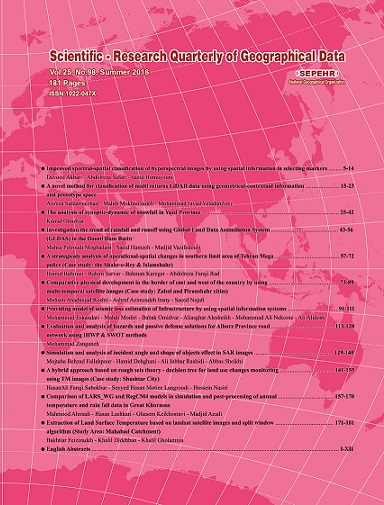Document Type : Research Paper
Authors
1 Assisstant Prof. Dep. Of geomorphology, Kharazmi University, Tehran, Iran
2 Assisstant Prof. Dep. Of geography, Razi University, Kermanshah, Iran
3 Ph.D. Student, Climatology, Dep. Of geography, Razi University, Kermanshah, Iran
Abstract
Abstract[1]
Vegetation cover has a high relationship with climatic conditions. Identification of the seasonal variation of plant growth to determine the response of ecosystems to climate change in seasonal and inter-annual time scales is decisive.To present a prediction model, 7 climatic elements including precipitation, temperature and relative humidity (maximum, average and minimum) for a 20 year period (1987-2006) were converted into spatial data in 141 synoptic and climatological stations. The combination of maximum monthly NDVI values from NOAA-AVHRR images was extracted in the same period. Then climatic elements and NDVI entered the multivariate linear regression as independent variable and dependent variable respectively. The results showed that the highest correlation coefficient between climatic elements and the amount of NDVI was 0.82 and happens in May that is the peak of greenery. The least correlation in winter is due to the lack of sufficient tree growth. Taking into account the random error, the annual correlation coefficient of the model amount with computational mode is more than 93/0. In total, the computational value of May and June for 2004 and 2005 is close to the correlation coefficient of the model, but in the winter months, the correlation coefficient decreases due to lack of greenness.In 2006, there was less prediction due to more severe dryness in the late spring (June). In winter, the role of temperature control is more than rainfall and relative humidity, but with increasing temperature and decreasing precipitation and relative humidity, the role of precipitation and relative humidity becomes positive and temperature becomes negative from the beginning of May. In the autumn, the role of precipitation decreases and the temperature is increased.
[1] - به دلیل کیفیت نامناسب متن چکیده مبسوط انگلیسیِ ارائه شده توسط نویسنده مسئول مقاله، نشریه به ناچار اقدام به ترجمه مجدد متن چکیده فارسی و انتشار آن به جای چکیده مبسوط انگلیسی نموده است.
Keywords

